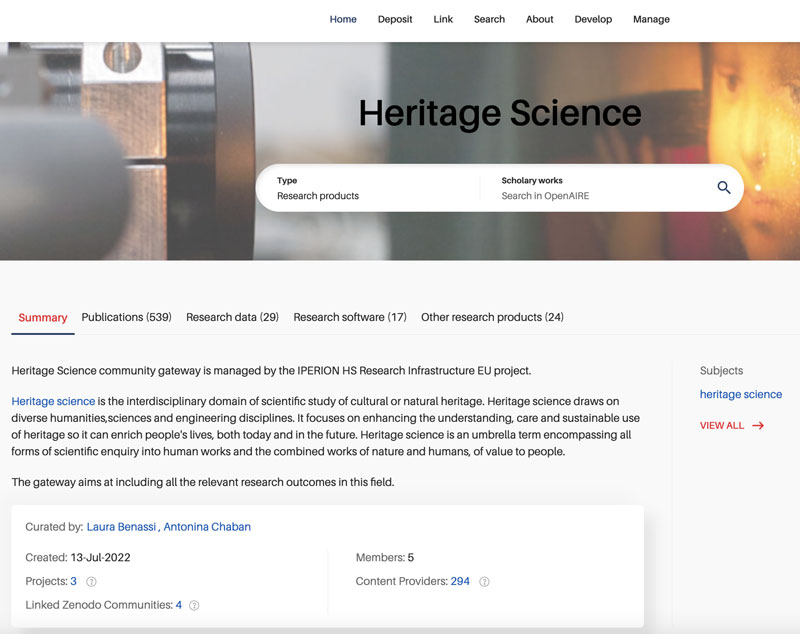by Alessia Bardi (CNR-ISTI) and Laura Benassi (CNR-INO)
IPERION HS is a research infrastructure that supports researchers in the field of heritage science, an interdisciplinary domain studying cultural and natural tangible heritage. This article describes how IPERION HS makes the research outputs open and accessible to the community and monitors its impact thanks to the services offered by the OpenAIRE infrastructure.
IPERION HS [L1] is a European infrastructure project working in the interdisciplinary domain of heritage science to understand, study and protect natural and cultural heritage. It contributes to establishing a pan-European research infrastructure on heritage science (E-RIHS). Led by the Italian National Research Council (National Institute of Optics), the consortium is composed of 24 national nodes across Europe and the US and collaborates with ICCROM, the intergovernmental organisation dedicated to the preservation of cultural heritage worldwide.
IPERION HS offers training and access to a wide range of high-level scientific instruments, methodologies, data and tools for advancing knowledge and innovation in heritage science. The research is actually focused on a better interoperability to data, sample materials, methods and instruments. Together with the users, the IPERION HS community is collecting an incredible amount of data and samples and working on the development of new protocols and instruments.
Making heritage science data open, findable and accessible is one of the main objectives of the IPERION HS infrastructure, whose Open Science strategy does not only include open access to publications, but also FAIR (findable, accessible, interoperable and reusable) and open data and methodologies. Tracking and monitoring the success of the strategy calls for technical tools capable of gathering together the research outputs of the IPERION researchers, which are published and deposited across different venues and repositories, and analysing the gathered data according to different perspectives, such as the types of outputs, their access rights, the policies of the journals they are published in, the availability of persistent identifiers and rich descriptive metadata, and the affiliations of the authors.
In addition, IPERION HS aims to support and ease the discovery of heritage science resources. Due to the high multidisciplinary aspect of the field, heritage science research resources are scattered in different repositories, archives, journals across the world and across many disciplines. Heritage science researchers, therefore, do not have a single web portal for searching for heritage science resources. On the contrary, they have to use many different thematic portals or the portals of large domain-agnostic aggregators. In the first case, researchers are likely to miss relevant sources; in the second they are likely to be overwhelmed by resources that are not interesting for them.
To address those challenges with a holistic approach, a new collaboration with OpenAIRE was launched in June 2022. OpenAIRE [L2] is a European infrastructure that promotes and supports the adoption of Open Science principles. It is composed of a distributed network of Open Science support desks and of a digital infrastructure with services that help institutions, research initiatives, communities and single researchers at embedding Open Science practices in all the different phases of the research life cycle. In particular, OpenAIRE is providing to IPERION HS three main services to strengthen, track and monitor the Open Science strategy of IPERION HS: Zenodo [L3], Connect [L4] [1] and Monitor [L5]. With Zenodo, IPERION HS offers to its researchers a trusted location where any type of research resources can be stored in a FAIR way. With Connect, IPERION HS is setting up an Open Research Gateway on Heritage Science [L6], where all research outputs of the domain are made discoverable, enabling searching and browsing across different sources (see Fig. 1). In addition, researchers can help grow the record of their community by adding links among research products and other entities of the research life cycle (e.g. this publication is supplemented by this dataset, the research described in that journal article has been funded by that project grant). The content available in the gateway is automatically updated by OpenAIRE based on a set of configuration criteria defined by gateway curators, who are members of IPERION and experts of the heritage science domain. In particular, gateway curators can select:
- domain-specific projects,
- thematic data sources (e.g. journals and repositories),
- thematic Zenodo communities,
- subject classification terms (free text keywords or terms from controlled vocabularies),
- affiliations.
OpenAIRE further assigns research products to the community based on the existing semantic relationships. For example, if a journal article is relevant for the community and is supplemented by a dataset, then the dataset is also added to the community. In order to add products that are relevant for the community but cannot be automatically detected as such, users can manually add them to the gateway with the Link functionality.
With a similar approach, OpenAIRE can identify the research outputs that have been produced thanks to the IPERION HS infrastructure and analyse the metadata to provide statistics and indicators about the uptake of Open Science, the compliance of its researchers to the Open Science policies, and the impact of the infrastructure on the research landscape.

Figure 1: Home page of the Open Research Gateway on Heritage Science.
The pilot collaboration between IPERION HS and OpenAIRE in the field of heritage science and the tools set up for practising Open Science will be the legacy to be left to E-RIHS (the European Research Infrastructure for Heritage Science), that will be established in the next few years with the headquarters in Florence, Italy. The heritage science community is facing the challenges of interoperability of research data and is building a reliable approach to describe, store, preserve and share the results globally. The operative support of OpenAIRE is becoming crucial for consolidating it.
Links:
[L1] https://www.iperionhs.eu/
[L2] www.openaire.eu
[L3] https://zenodo.org/communities/871034
[L4] https://connect.openaire.eu
[L5] https://monitor.openaire.eu
[L6] https://heritage-science.openaire.eu/
References:
[1] M. Baglioni, et al., “The OpenAIRE Research Community Dashboard: On Blending Scientific Workflows and Scientific Publishing”, in Proc. TPDL 2019 in LNCS vol. 11799, pp. 56–69, Springer, Ed. https://doi.org/10.1007/978-3-030-30760-8_5
Please contact:
Alessia Bardi , CNR-ISTI, Italy
Laura Benassi , CNR-INO, Italy











